
When you can’t get up close and personal, how do you build relationships with folks online?
Are you Linking In?
If not, it’s time to take a new look at this social platform to appreciate it for the beneficial research and relationship-building strategy it can be for you.
I find it to be a highly under-utilized tool when it comes to building your nonprofit brand, establishing authority and credibility, researching and recruiting new volunteers, donors and employees, and building stronger relationships with your current constituents.
Today we’re going to talk about how to use LinkedIn to uncover new donor prospects and build donor relationships.
Not too much. Just four no-nonsense strategies. We’ll look at two more in my next article.
To begin, so you can see how this might actually be helpful, I want you to take a look at your personal life.
How do you stay in touch with friends and family online?
How do you get the latest news, share your own news and give valuable feedback? In short, when you’re not able to get up close and personal, how do you build relationships online?
Chances are, depending on your generation, you use Facebook or Instagram or Twitter. Your donors are apt to use these platforms as well. And… guess what? Many of them are also likely to use LinkedIn.
LinkedIn is where people in business connect.
You know, C-suite executives, people aspiring to become C-suite execs, entrepreneurs, venture capitalists and folks with jobs, money and networks of other folks with capacity to become donors.
I’m not suggesting you ignore other channels, online or offline. I’m simply suggesting you consider making more of an investment in LinkedIn than you have heretofore. And I’m going to suggest a few easy-to-accomplish strategies outlined by Robbie Abed in an article on Inc.: Build Better Relationships on LinkedIn Using These 3 Simple Steps. His article is not specifically directed to nonprofits, but the principles apply. And I’m going to show you how!
First, you need to begin building your LinkedIn network!
It was a lightbulb moment for me when I realized I could message donors for whom I didn’t have emails and ask if I could join their network. Most of these folks were people I already knew, but I had no way to connect with them online. I was pleasantly surprised (shocked, actually) by how receptive folks were to this approach.
True Story: There was a C-Suite executive (generous philanthropist in town) who I saw was a low-level donor to our organization. He happened to be a member of my congregation, and I had once heard him speak. So I knew a little bit about his philanthropic interests, and I thought there was a terrific match between his expressed values and those our nonprofit enacted. I had no email address or phone number. So… I reached out on LinkedIn telling him what I knew about him, what we had in common, and suggesting he might want to learn more about what we were doing. He responded immediately with a friendly greeting. He didn’t want to meet, but was more than happy to keep up a correspondence on LinkedIn. We did this for no more than a few months when, lo and behold, a six-figure check showed up at our offices!
So… If you don’t have contact information for someone you want to reach, see if you can find it on LinkedIn.
Okay, let’s get down to some bonding and rapport building brass tacks (we’ll look at two more in my upcoming article: 2 Strategies to Build Donor Relationships on LinkedIn.)
Next, you must give people a reason to learn more about and connect with you.
You’ve probably heard me say that in our digitally-revolutionized world, folks are two-thirds down the road towards forming an impression about you before you even know they exist. Marketing has changed, and there’s no going back. Outbound marketing (where you define your brand, carefully craft your message and then broadcast it out to form your audience’s opinion of you) has pretty much died. Today it’s all about inbound communicating.
You know, don’t you, that when someone comes across your nonprofit’s name they’ll often “Google” you to see what else they can find. All your social media channels will come up. You can’t control what’s said about you on Yelp or Facebook or Twitter, but you can control your own social profile.
1. A complete, accurate and up-to-date LinkedIn profile is a must.
If you don’t have a LinkedIn account yet, create one.
If you do, update it and assure you’re putting your best foot forward. Here are some tips:
1. Claim your LinkedIn Company Page and keep it current. Make sure you optimize your profile by filling everything out and updating it regularly. Every time you make even a small update your followers are alerted, thus keeping you top of mind.
2. Make sure you have a great profile picture reflecting your brand. This is the first thing people will see, and it’s your best opportunity to create a positive impression that truly communicates your mission and credibility. Most nonprofits will upload a logo as the profile photo (see instructions) and use a relevant cover photo for the banner image (see instructions).Take a look at the good, and not so good, examples below.
 St. Judes chose to highlight their connection to their famous celebrity founder to establish their longevity. They also highlight the ‘social proof’ that comes from receiving a third party “best children’s hospital” designation.
St. Judes chose to highlight their connection to their famous celebrity founder to establish their longevity. They also highlight the ‘social proof’ that comes from receiving a third party “best children’s hospital” designation.
 Shriner’s Hospital is not taking advantage of their profile photo space.
Shriner’s Hospital is not taking advantage of their profile photo space.
 ASPCA showcases cute animals being rescued.
ASPCA showcases cute animals being rescued.
 Humane Society fails to take advantage of valuable profile space.
Humane Society fails to take advantage of valuable profile space.
3. Tell a compelling story that spells out the specifics of your mission; don’t just list a bunch of facts and achievements. Have an absorbing ‘overview’ summary that helps folks visualize what you do. Don’t forget to include a call-to-action at the end so people can reach out if they have questions of feel compelled to help.
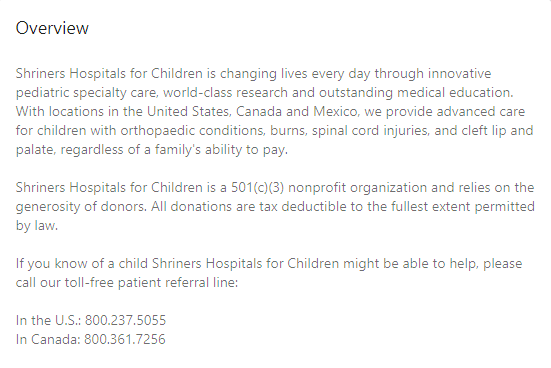 Shriners has two CTAs. One is to refer potential people in need. One is to donate.
Shriners has two CTAs. One is to refer potential people in need. One is to donate.
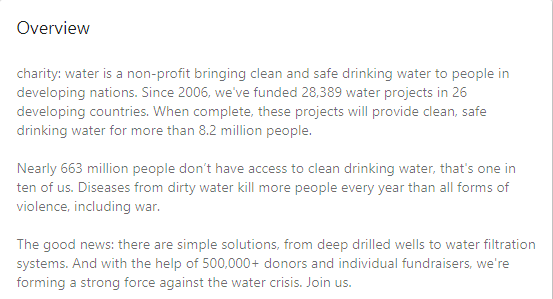 Charity Water makes the problem relatable, noting how 1 in 10 people on the planet don’t have clean water, and this causes more deaths than war.
Charity Water makes the problem relatable, noting how 1 in 10 people on the planet don’t have clean water, and this causes more deaths than war.
2. Suggest to staff, volunteers and lay leaders that they add you to their own LinkedIn profile, thus extending your reach to their networks.
You may have noticed in the examples above how the profile header will say See all 2,930 employees on LinkedIn. Not only will a visitor to your LinkedIn page now be able to connect directly with your team, but visitors to your team member’s individual pages will also find a link back to your company profile and website.
You may want to create guidelines that include descriptive copy your staff can use in their profiles. Use a tool like Google Docs so you can update these easily.
3. Write articles for LinkedIn.
This is a great way to establish yourself as a thought leader and create engagement. There are two ways to do this.
1. Simply publish a link to articles from your own blog. It’s a good idea to have a LinkedIn share button on your blog so others can do this sharing for you as well.
2. Write articles directly on the LinkedIn platform. It’s a great way to become known as leader in your area of expertise. Here’s an article all about writing articles for LinkedIn: 8 Steps for Writing a Smart LinkedIn Article.
4. Offer regular updates to stay top of mind with current constituents and draw new people to connect with you.
This is similar to sending an update on any other social platform. Your best bet is to share a compelling photo, or even a video, with a small amount of text. You can also include links back to your website (e.g., to learn more, read a fuller story or take a desired action). This is also an awesome opportunity to send expressions of gratitude to your community. And you can even ask people to donate to you!
What you want to avoid is failing to show up. If you set up a LinkedIn page, and don’t use it, you appear missing inaction. You don’t inspire confidence. If you’re not going to be active, don’t bother. Because this looks sad.
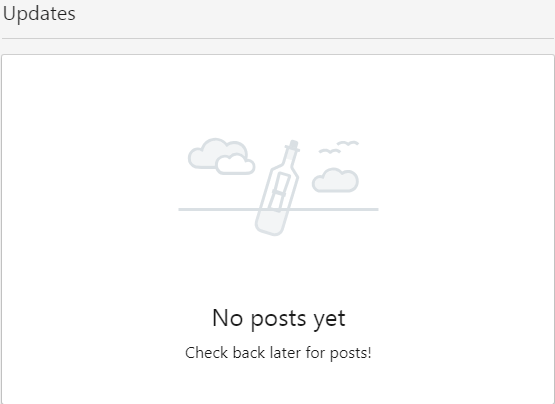
Strive to use your updates to accomplish multiple objectives. You might simply want to showcase your impact to establish credibility and arouse interest. Or perhaps you want to show off your brand personality and attract like-minded folks. Sometimes you want people to take a particular action, be it attend an event, sign up to your email list, sign a petition, share your post with their network or make a donation.
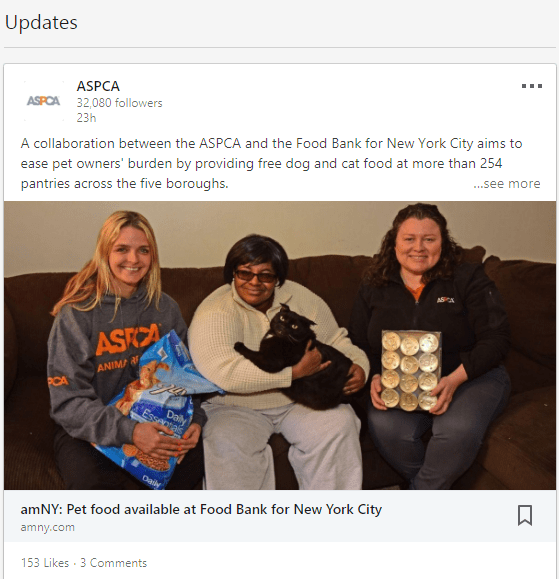 ASPCA offers an update telling the story of their collaboration with a local food bank, establishing they’re active partners in building a better community.
ASPCA offers an update telling the story of their collaboration with a local food bank, establishing they’re active partners in building a better community.
 Heifer International combines a ‘fun fact’ with an opportunity to learn more and potentially donate.
Heifer International combines a ‘fun fact’ with an opportunity to learn more and potentially donate.
 San Francisco-Marin Food Bank shares a video that offers a testimonial from a client, oriented to establish credibility and inspire donations.
San Francisco-Marin Food Bank shares a video that offers a testimonial from a client, oriented to establish credibility and inspire donations.
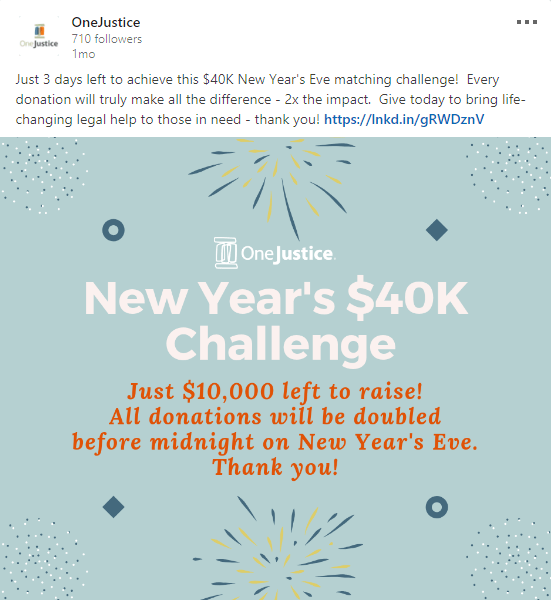 One Justice asks folks to donate to their year-end campaign.
One Justice asks folks to donate to their year-end campaign.
You might also consider setting aside some advertising budget for sponsored updates, which will push your content to new audiences. Other updates will reach only those who follow and/or search for your company page.
Don’t forget to record what you learn and what you do!
Relationships are built on give and take. It’s not sufficient to simply reach out one time and then check this action off your list as ‘done.’
Make a record or everything you do, and everything you learn, in your donor database. Part of building donor relationships is showing folks you know them. If they tell you something, and you then take no notice of it, they feel you didn’t see them. No one likes to be ignored.
It’s also a good idea to make a note of your next planned action. Schedule this using your database or calendar so you’re notified when it’s time for the next step.
Bottom line: I suggest you make greater use of LinkedIn. It’s an underutilized tool. A big treasure trove of opportunities to find new prospects, define your brand, establish your leadership, authority and credibility, and build relationships with current constituents.
Related article:
Your Nonprofit Can Do a Lot More on LinkedIn Than You Think

When you can’t get up close and personal, how do you build relationships with folks online?





